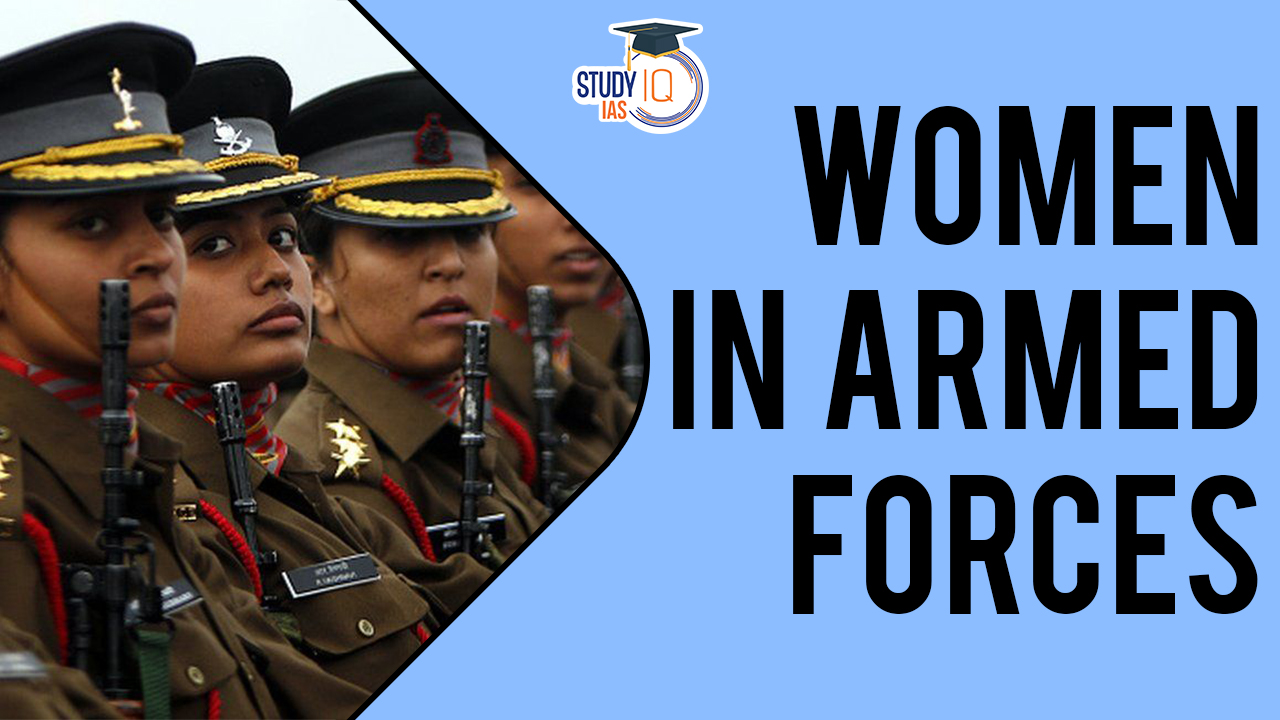Table of Contents
Context: For the first time in the history of the Army, women from the Officers Training Academy (OTA) will be inducted into the Army’s Regiment of Artillery.
Brief Background of Women in Indian Armed Forces

Current state of Women in Indian Armed Forces
- There are 9,118 women currently serving the army, navy and air force.
- Women comprise only 3.8% of the Indian army (world’s second-largest army) – compared to 13% of the air force and 6% of the navy.
- All branches of the Indian Armed Forces have women in combat roles. Women are allowed in combat services and supervisory roles (as officers).
- As of 2020, three officers have the rank of lieutenant-general or equivalent, all in the Medical Services.
- In May 2021, 83 women were inducted as Jawans for the first time in the Indian Army, in the Corps of Military Police.
- Global comparison:
- Israel: Israel is known for its high representation of women in the armed forces. As of 2021, women comprise about 33% of the Israeli Defense Forces (IDF), including combat roles in the air force, navy, and infantry.
- United States: The United States is considered a pioneer and a trend-setter as regards induction of women in the services. There are approximately 200,000 American women on active duty in the US armed forces. They constitute nearly 20 percent of its strength.
- Britain: Today, 71% of all jobs in the Navy, 67% in the Army and 96% in the Air Force are tenable by women. Women are primarily excluded from the duties which require battling enemy at close quarters.
What are the advantages of Women joining the Armed Forces?
- Ability vs Gender: Gender should not be a factor in the recruitment of military personnel, as long as the applicant meets the required qualifications, and many women are in better shape than many men sent into combat.
- In modern high technology battlefield, technical expertise and decision-making skills are increasingly more valuable than physical strength.
- Breaking Gender Stereotypes: Women joining the armed forces can help to break down gender stereotypes and promote gender equality. This can have a positive impact on society as a whole, encouraging greater respect for women and their abilities.
- To uphold Right to Equality: Articles 14, 15, 16 and 19 of the Constitution, which uphold the values of equality and allow equal, non-discriminatory opportunities at work, were being violated by denying eligible women the opportunity.
- Military Readiness: Allowing a mixed gender force keeps the military strong. The armed forces are severely troubled by falling retention and recruitment rates. This can be addressed by allowing women in the combat role.
- Diversified talent pool: The inclusion of women in the armed forces increases the recruitment pool, allowing for a more diverse and representative military.
- Leadership: Women encourage participation and share power and information as they have learnt this since their childhood, and yet are ruthless when the situation demands.
Issues associated with Women in Armed Forces
| Physical issues | Physical Ability: The standards of physical fitness have been set to suit men, and women attempting to overcome them could create biological hurdles.
Feasibility: While integration of women into combat is possible for those qualified, which is a small number versus the additional logistical, regulatory and disciplinary costs associated with integration may make integration of women a less feasible affair. |
| Social issues | Low acceptance: Both male and female prisoners are at risk of torture and rape. There is low acceptance in societies to abuse women prisoners of war by the enemy.
Family imbalance: Centre said that armed forces require sacrifices and commitment beyond the call of duty by the entire family of service personnel involving separation and frequent transfers, affecting the education of children and career prospects of the spouse. |
| Administrative issues | Morale & Cohesion: Having women serving in direct combat may hamper mission effectiveness by hurting unit morale and cohesion as the mindset of an average soldier on the ground remains averse to having a woman leader. |
Prominent examples of Women in Indian Armed Forces
- Gunjan Saxena – She is a former IAF officer who became the first woman to fly in a combat zone during the 1999 Kargil War between India and Pakistan.
- Padmavathy Bandopadhyay – She became the first woman Air Marshal of the Indian Air Force in 2004.
- Bhawana Kanth – In 2016, she became the first woman to be inducted into the fighter stream of the Indian Air Force (IAF).
- Tania Shergill – She became the first woman Parade Adjutant for the Republic Day parade in 2020, leading an all-male contingent of the Indian Army.
Conclusion
- With future war fighting becoming more sophisticated and technologically advanced, there is a growing need to tap into the large pool of skilled women and ensure that they are represented across all ranks of the armed forces. To achieve this goal, it is essential to promote the concept of meritocracy, whereby individuals are selected based on their capabilities rather than their gender.


 SSC CGL Exam 2025 Apply Online Starts Ap...
SSC CGL Exam 2025 Apply Online Starts Ap...
 Daily Quiz 19 April 2025
Daily Quiz 19 April 2025
 Vehicle-to-Grid (V2G) Technology and its...
Vehicle-to-Grid (V2G) Technology and its...





















